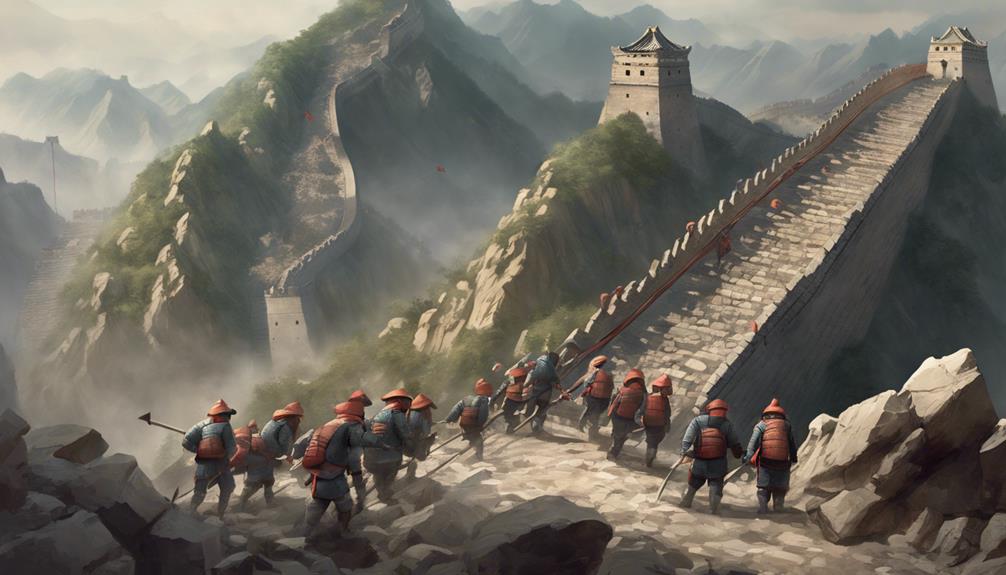The construction of the Great Wall of China stands as a monumental achievement in ancient architectural history, prompting scholars and historians to ponder the underlying motivations behind its creation. Beyond its awe-inspiring length and imposing structure, the reasons driving the construction of this colossal fortification lie deeply rooted in strategic, economic, and cultural imperatives that shaped the course of Chinese history. By examining the multifaceted purposes behind the Great Wall's construction, we can unravel the intricate layers of significance that continue to intrigue researchers and enthusiasts alike, shedding light on the enduring legacy of this iconic symbol of China's past.
Key Takeaways
- Defense against nomadic tribes and invaders
- Protection of trade routes and Chinese territories
- Integration of military defense and strategic positioning
- Promotion of cultural cohesion and national unity
Historical Context of the Great Wall
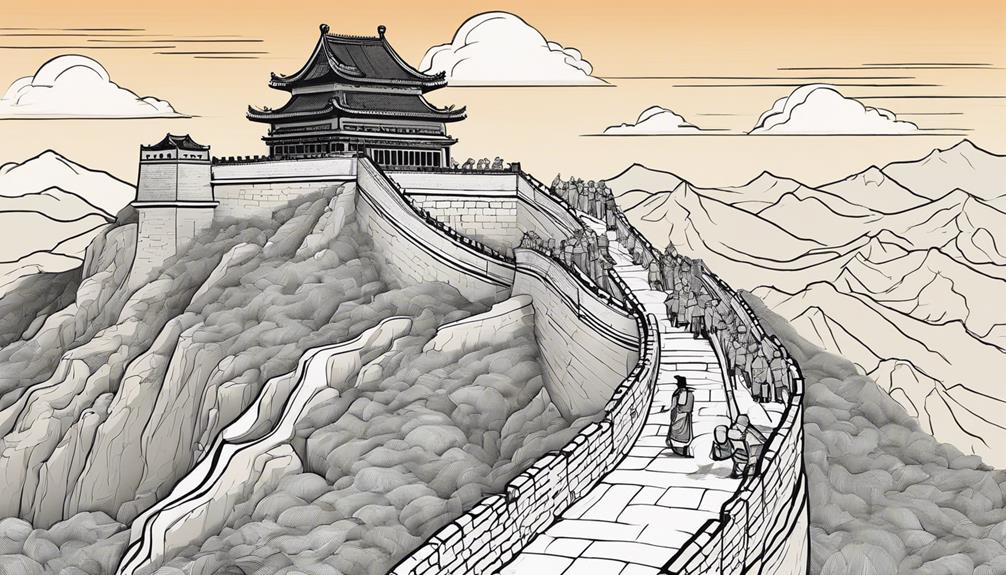
The historical context surrounding the construction of the Great Wall of China is deeply rooted in the strategic imperatives of ancient Chinese dynasties. Built primarily for defense against invading nomadic tribes, the wall played a crucial role in border control, regulating trade, and protecting Chinese territories. Strategically positioned watchtowers, troop barracks, and signaling capabilities were integrated into the wall's design to enhance its defensive capabilities.
Various Chinese dynasties undertook repair and expansion efforts over time to strengthen the wall's ability to repel invaders. The Great Wall not only served as a physical barrier but also functioned as a transportation corridor, facilitating movement and communication within the empire. This dual role of defense and communication highlights the strategic foresight of the Chinese rulers in utilizing the wall not just as a fortification but also as a means to maintain internal cohesion and respond swiftly to external threats.
Qin Dynasty Construction Efforts
Emperor Qin Shi Huang's decision to construct the Great Wall marked the genesis of a monumental construction effort aimed at fortifying the empire's borders. The strategic military defense strategy of the Qin Dynasty necessitated the creation of a formidable barrier to protect against potential invasions. This massive undertaking reflected the dynasty's commitment to ensuring the security and integrity of its territories through innovative construction methods and meticulous planning.
Qin Dynasty Beginnings
Initiated by the Qin Dynasty in 220 B.C., the construction efforts of the Great Wall of China were overseen by General Meng Tian, utilizing the labor of soldiers, convicts, and commoners. The Qin Dynasty's construction of the Great Wall aimed primarily at defending against invasions from nomadic tribes like the Xiongnu. Construction began with earth and stone materials, spanning over 3,000 miles initially. Throughout history, various dynasties such as the Northern Wei, Bei Qi, and Ming continued to extend and repair the wall for defensive purposes.
- General Meng Tian supervised construction with soldiers, convicts, and commoners
- Initial construction spanned over 3,000 miles with earth and stone materials
- The primary goal was defense against nomadic tribes like the Xiongnu.
Military Defense Strategy
Bearing in mind the strategic imperative of protecting against nomadic incursions, the construction efforts of the Qin Dynasty for the Great Wall of China were meticulously calculated to establish a robust military defense strategy. The wall served as a comprehensive defensive system, integrating beacon towers, fortresses, and strategic passes strategically placed along its length. These elements worked cohesively to deter and defend against invasions from nomadic nations, safeguarding the Chinese civilization. In ancient battles, the Great Wall played a pivotal role by providing a strong line of defense, showcasing its effectiveness in military defense. The systematic design of the wall reflected the importance placed on ensuring the safety and security of the territory and its people.
| Defensive Components | Description | Purpose |
|---|---|---|
| Beacon Towers | Tall structures for signaling and alerting | Early warning system |
| Fortresses | Strongholds for troops and supplies | Defense and strategic control |
| Strategic Passes | Key entry points controlled by the military | Regulate movement and defense |
Border Protection Purpose
With a focus on enhancing border security and fortifying territorial defenses, the construction efforts of the Qin Dynasty for the Great Wall of China were meticulously executed to safeguard against nomadic invasions.
- Qin Shi Huang integrated existing walls to create a unified system, bolstering border defenses.
- General Meng Tian spearheaded construction efforts, utilizing labor from soldiers, convicts, and commoners.
- The defensive purpose was paramount in protecting Chinese states from external threats, particularly repelling nomadic tribes like the Xiongnu. The strategic positioning and sturdy structure of the Great Wall aimed to deter and thwart potential invasions, showcasing the Qin Dynasty's commitment to securing its borders against incursions.
Ming Dynasty Wall Building Techniques
The construction of the Great Wall of China during the Ming Dynasty prominently featured the utilization of bricks, tiles, lime, and stone as essential building materials. Bricks, known for their durability and strength, were favored in constructing the Ming dynasty sections of the wall. The use of sticky rice mortar, a technique unique to Chinese architecture, played a crucial role in binding these materials together. The Ming dynasty's wall building techniques were meticulously planned, considering the terrain and strategic requirements of different sections. This careful selection of materials and methods not only enhanced the structural integrity of the wall but also contributed significantly to its preservation over centuries. The combination of these elements ensured that certain sections of the Great Wall built during the Ming Dynasty have withstood the test of time, standing as a testament to the skill and ingenuity of ancient Chinese builders.
Strategic Importance of the Wall
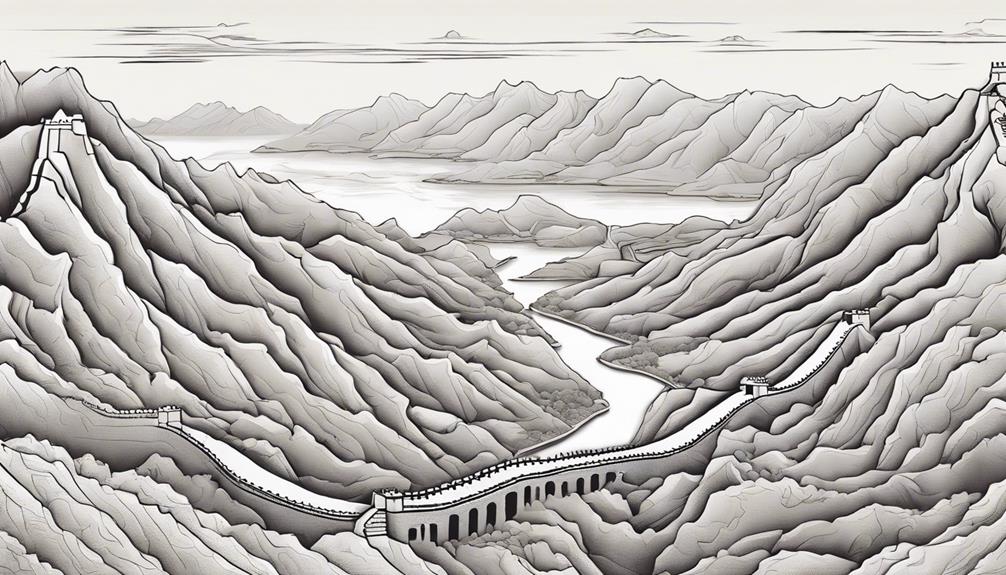
In understanding the historical context surrounding the Ming Dynasty Wall Building Techniques, it becomes evident that delving into the Strategic Importance of the Wall reveals a pivotal aspect of its enduring legacy as a vital defensive structure. The Great Wall of China served as a comprehensive defensive system, integrating beacon towers, fortresses, and strategic passes to protect the Han people and their territory. This strategic layout enhanced defensive capabilities, ensuring battle readiness and safeguarding the northern border of China. Additionally, the wall played a crucial role in ancient battles by effectively blocking invasions and securing the region. Efficient communication systems, such as the beacon towers, facilitated rapid delivery of battle signals along the wall, contributing to the overall defensive strategy.
- The Great Wall functioned as a defensive system, incorporating beacon towers and fortresses.
- It protected strategic passes, enhancing its defensive capabilities.
- The wall's communication systems, like beacon towers, ensured swift and effective transmission of battle signals, contributing to battle readiness.
Economic Benefits of the Wall
Enhancing trade routes and fostering economic prosperity, the Great Wall of China played a pivotal role in facilitating safe and secure exchanges along the Silk Road. Acting as a protective barrier, the Wall ensured the safety of trade routes and enabled the smooth flow of economic exchanges between China and its neighboring regions. By safeguarding these vital passages, the Wall contributed significantly to the economic growth and prosperity of the region. The defensive capabilities of the Wall not only protected against external threats but also helped maintain stability, creating an environment conducive to flourishing economic activities. Trade caravans traversing the Silk Road could do so with increased confidence due to the presence of the Great Wall, which in turn boosted commercial interactions and cultural exchanges. The Wall's strategic location and robust defenses were instrumental in fostering a climate where trade could thrive, making it an essential asset for the economic well-being of the region.
Protection of the Silk Road
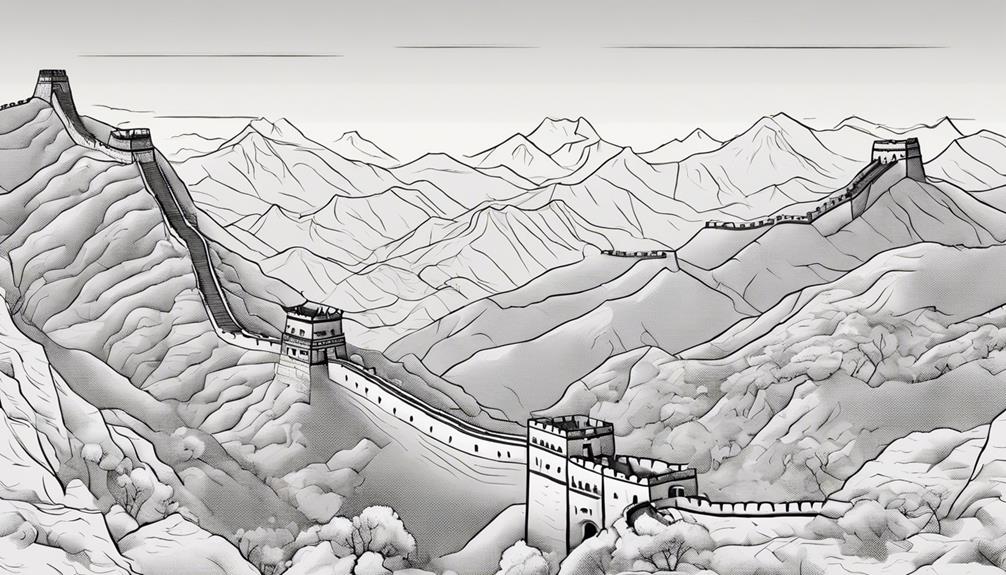
The protection of the Silk Road was a primary objective in constructing the Great Wall of China, aiming to secure the crucial trade route from external threats. By fortifying the wall, Chinese rulers could defend against invasions and maintain the flow of goods along the Silk Road. Safeguarding this trade route was essential for ensuring economic prosperity and political stability in the region.
Silk Road Defense
Strategically positioned along the Silk Road, the Great Wall of China was a crucial defense mechanism ensuring the security and prosperity of this vital trade route.
- The wall protected the Silk Road from invasions that could disrupt trade between the East and West.
- It facilitated cultural exchange and economic stability by safeguarding merchants and their goods.
- Its strategic location near the Silk Road deterred potential threats and played a vital role in maintaining the continuous flow of trade.
Trade Route Security
Positioned strategically along the Silk Road, the Great Wall of China functioned as a pivotal defense structure safeguarding the vital trade route and ensuring the secure passage of goods and merchants between China and the Western civilizations. The wall acted as a significant barrier against invasions and raids, protecting economic exchanges and cultural interactions along the Silk Road. Its strategic location deterred disruptive elements such as bandits and nomadic tribes, maintaining stability and security for trade caravans. By serving as a safeguard for the Silk Road, the Great Wall played a crucial role in facilitating peaceful commerce and diplomatic relations between China and its trading partners. The table below summarizes the key points related to the trade route security provided by the Great Wall of China.
| Keyword | Description |
|---|---|
| Silk Road | Vital trade route connecting China with the Western world |
| Barrier | Strategic defense structure preventing invasions and raids |
| Safeguard | Ensuring safe passage of goods, merchants, and caravans |
| Economic Exchanges | Protecting economic interactions and cultural exchanges along the Silk Road |
Border Safeguarding
Functioning as a pivotal defensive structure along the Silk Road, the Great Wall of China was erected to safeguard the northern borders of China and protect the vital trade route.
- The Great Wall of China was built to act as a defensive barrier against invasions, securing the northern borders and ensuring the safety of the Silk Road.
- Its construction aimed to regulate trade and control movement along the Silk Road, enhancing security for economic and cultural exchanges.
- By fortifying the border, the Great Wall played a crucial role in maintaining stability and safeguarding the trade routes, ultimately benefiting China's diplomatic relations and economic prosperity.
Cultural and National Integration Goals
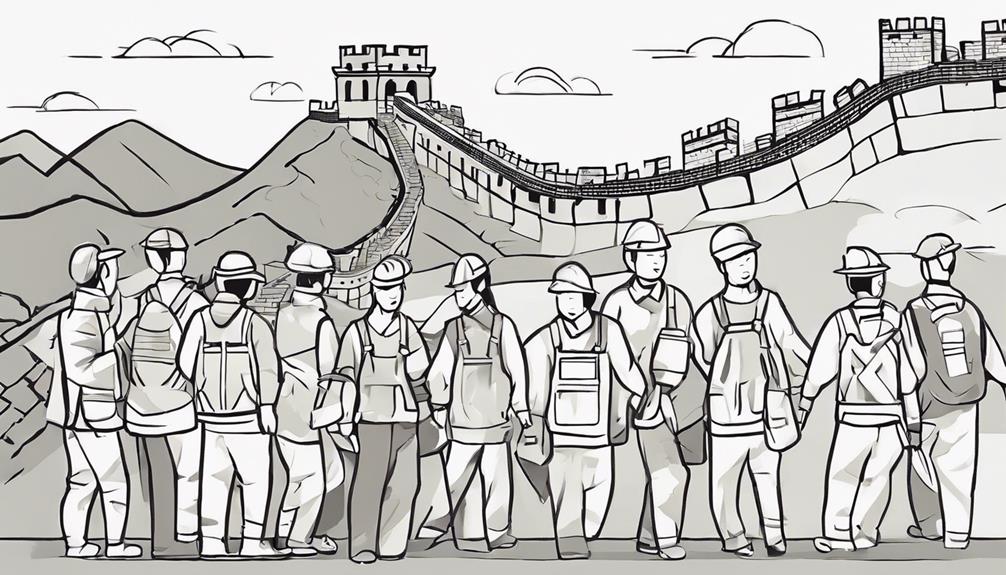
The construction of the Great Wall of China was driven by a profound aspiration to foster cultural cohesion and national unity among the diverse Chinese populace. It aimed to integrate various regions and communities under one national identity, symbolizing the collective strength and solidarity of the Chinese civilization. The wall's significance lay in its role as a unified front against external threats and invasions, safeguarding the integrity of the Chinese territories. By physically connecting and protecting diverse regions, the Great Wall promoted a shared sense of belonging and heritage among the people of China. This monumental structure not only served as a physical barrier but also as a symbolic representation of the collective identity and unity of the Chinese nation. The cultural and national integration goals of the Great Wall underscore the historical necessity for unification and strength in the face of external challenges, emphasizing the importance of solidarity and a shared heritage in shaping Chinese civilization.
Military Significance of the Wall
In understanding the historical imperative behind the construction of the Great Wall of China, it becomes evident that delving into the military significance of this monumental structure is paramount to comprehending its strategic relevance in safeguarding the northern borders of ancient China.
- The Great Wall integrated beacon towers, fortresses, and strategic passes to enhance military readiness and response against nomadic invasions.
- By creating a fortified defense line, the wall effectively hindered incursions from nomadic nations, protecting the Han people and their territory.
- It played a crucial role in ancient battles by providing a structured military defense strategy that helped in repelling invasions and maintaining territorial integrity.
The Great Wall of China, with its interconnected system of defenses and strategic placements, stood as a formidable barrier against external threats, showcasing the meticulous planning and military acumen of ancient China in safeguarding its borders.
Great Wall as a Symbol of China
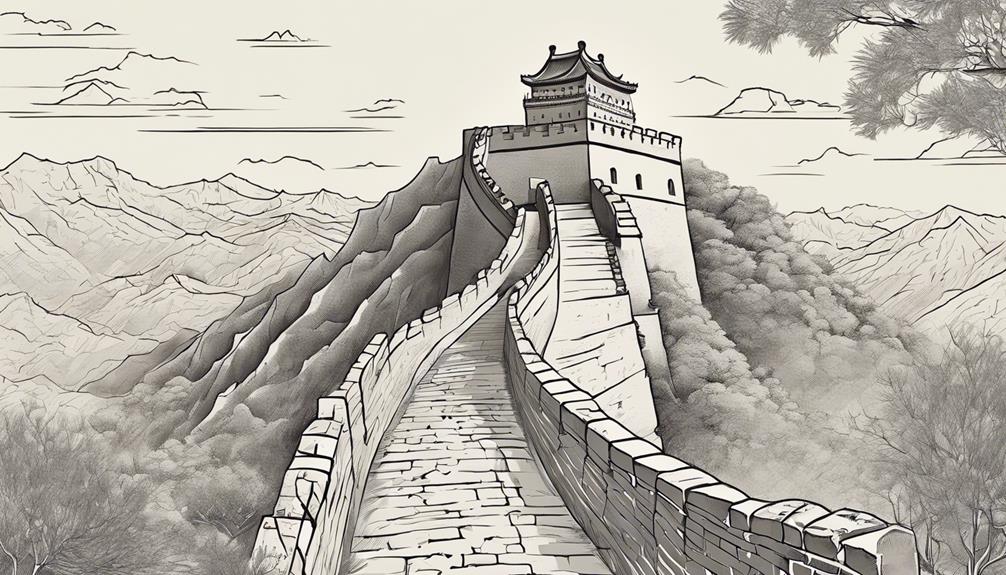
The Great Wall of China stands as an enduring symbol of China's rich cultural heritage and historical significance. Its construction reflects the strategic importance placed on defense and unity in ancient Chinese civilization. The wall's designation as a UNESCO World Heritage site underscores its global recognition as a testament to China's architectural and engineering achievements.
Cultural Significance of Great Wall
Evidencing China's enduring legacy and strategic acumen, the Great Wall stands as an iconic symbol of the nation's historical fortification methods and cultural unity. The Wall represents the architectural prowess and engineering feats of ancient China, showcasing the nation's ability to construct massive structures. Designated as a UNESCO World Heritage site in 1987, the Great Wall holds immense cultural significance, drawing millions of tourists yearly who seek to witness its historical importance firsthand. This ancient marvel serves as a testament to China's rich history and ancient civilization, encapsulating the unity and defensive strategies of the past. The Wall's presence resonates deeply with the global community, highlighting China's contributions to both architectural innovation and historical preservation.
- Architectural prowess and engineering feats
- Cultural significance and historical importance
- Unity and defensive strategies
Historical Defense Importance
Symbolizing China's historical military prowess and strategic foresight, the Great Wall of China stands as a formidable testament to the nation's commitment to safeguarding its borders against invasions from nomadic groups. The Great Wall served as a comprehensive defensive system, protecting the Han people and their territory by connecting beacon towers, fortresses, and strategic passes. It played a vital role in ancient battles, showcasing China's military strength and determination to defend its lands. Not only did the wall act as a physical barrier, but it also enhanced battle readiness, facilitated supply transport, and fortified the nation's defensive capabilities. The strategic significance of the Great Wall extended far beyond mere defense, reflecting China's enduring dedication to protecting its borders.
| Defensive System | Han People | Military Strength | Strategic Passes |
|---|---|---|---|
| Comprehensive network | Protection ensured | Symbol of power | Strategic advantages |
Impact on Modern China
Influence on modern China emanates from the Great Wall's historical significance, shaping the nation's identity and fostering a sense of national pride. The impact of the Great Wall on modern China can be observed in various aspects:
- Economic Contribution: The preservation and tourism surrounding the Great Wall play a vital role in China's economy, attracting both domestic and international tourists and generating substantial revenue.
- Cultural Emblem: Modern China uses the Great Wall as a symbol of its rich history and cultural heritage, showcasing the country's ancient defensive strategies and highlighting its enduring legacy.
- Tourism Magnet: The wall's iconic status draws millions of visitors annually, serving as a popular tourist destination that not only educates visitors about China's past but also instills a sense of awe and admiration for the architectural marvel.
The Great Wall stands not only as a physical monument but also as a profound representation of China's past, present, and future, solidifying its position as a cornerstone of the nation's identity and pride.
Frequently Asked Questions
Why Did China Built the Great Wall?
The Great Wall of China was constructed to fortify the nation's strategic defense and ensure effective border control. This monumental structure symbolized unity among the Chinese people, showcasing their cultural heritage and military strategy. Its ancient architecture and the immense labor force involved in its construction reflected a commitment to dynastic protection. Overall, the Great Wall served as a formidable barrier against external threats, embodying the nation's determination to safeguard its territory.
What Was the Main Reason for Constructing the Great Wall of China Quizlet?
The main reason for constructing the Great Wall of China was to establish a formidable military defense system due to its strategic location. Its primary purpose was to protect Chinese territories from invasions, particularly from Mongolian threats. Emperor Qin initiated the construction to unify and fortify the nation. The wall's ancient construction required a significant labor force, contributing to its historical significance and cultural heritage. Additionally, it played a crucial role in regulating trade routes and had substantial economic impact.
How Much of the Great Wall of China Is Still Standing?
Approximately 8.2% of the Ming Great Wall of China is still standing, with some sections well-preserved and others in disrepair. Restoration efforts are ongoing to protect this architectural marvel with historical significance. Despite being a popular tourist attraction, maintenance challenges persist due to erosion and human activities. Protection measures are being implemented to safeguard different wall sections, highlighting the modern uses and the importance of preserving this iconic structure.
How Many Times Was the Great Wall of China Breached?
The Great Wall of China, a remarkable feat of architecture, faced historical breaches by military invasions. Despite its formidable defense strategies, the wall was breached several times due to structural weaknesses. These breaches led to significant consequences such as the fall of dynasties. To enhance border control and security, reinforcement efforts were made, and surveillance systems were implemented. The Great Wall's historical breaches highlight the challenges faced in safeguarding vast territories.
Conclusion
In conclusion, the Great Wall of China stands as a monumental architectural achievement with profound historical significance. Its construction and expansion efforts by various dynasties were driven by strategic, economic, and cultural considerations aimed at enhancing defense, regulating trade, and fostering national unity. The wall's enduring presence symbolizes China's rich history and resilience. Its impact on modern China is immeasurable, solidifying its reputation as a marvel of human ingenuity and determination.
